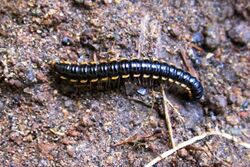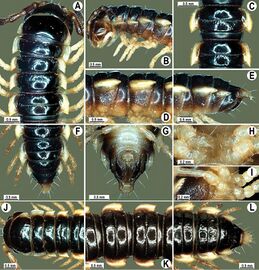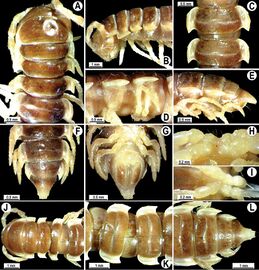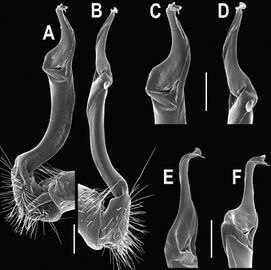Biology:Orthomorpha coarctata
| Orthomorpha coarctata | |
|---|---|

| |
| Scientific classification | |
| Domain: | Eukaryota |
| Kingdom: | Animalia |
| Phylum: | Arthropoda |
| Subphylum: | Myriapoda |
| Class: | Diplopoda |
| Order: | Polydesmida |
| Family: | Paradoxosomatidae |
| Genus: | Orthomorpha |
| Species: | O. coarctata
|
| Binomial name | |
| Orthomorpha coarctata (De Saussure, 1860)
| |
| Synonyms | |
| |
Orthomorpha coarctata, the long-flange millipede,[1] is a widely introduced species of Polydesmidan millipede of the family Paradoxosomatidae. It is presumed native to Southeast Asia but due to transport by humans occurs in tropical and sub-tropical areas throughout the world, including the Hawaiian Islands, the West Indies, Gulf Coast of North America, and the Galápagos Islands.[1][2][3]
Description
Males range from 14.5–20.5 mm in length and 1.5 to 2.7 mm wide while females are somewhat larger ranging from 16.5–27.5 mm long, and 1.6–3.2 mm wide.[4] O. coarctata can be distinguished from Oxidus gracilis, another widely introduced Asian millipede, by having proportionally longer and pointier paranota (lateral keels) on mid-body segments and longer gonopods (male reproductive appendages).[5]
O. coarctata is unique within the genus Orthomorpha in that the gonopods have a single, simple tip, while other species have two or three lobes. This distinction has led some authors to place O. coarctata in a separate, monotypic genus, Asiomorpha.[2][4]
References
- ↑ 1.0 1.1 McCormack, Gerald (2007). "Asiomorpha coarctata, Long-flange Millipede". Cook Islands Biodiversity Database, Version 2007.2.. Cook Islands Natural Heritage Trust, Rarotonga. http://cookislands.bishopmuseum.org/species.asp?id=9073. Retrieved 20 May 2014.
- ↑ 2.0 2.1 Hoffman, R. L. (1999). "Checklist of the millipeds of North and Middle America". Virginia Museum of Natural History Special Publications 8: 1–553. p. 415
- ↑ Peck, S. B. (1998). "Introduced insect fauna of an oceanic archipelago: The Galápagos Islands, Ecuador". American Entomologist 44 (4): 218–237. doi:10.1093/ae/44.4.218. https://academic.oup.com/ae/article-pdf/44/4/218/18740333/ae44-0218.pdf. p. 220
- ↑ 4.0 4.1 Likhitrakarn, Natdanai; Golovatch, Sergei; Panha, Somsak (2011). "Revision of the Southeast Asian millipede genus Orthomorpha Bollman, 1893, with the proposal of a new genus (Diplopoda, Polydesmida, Paradoxosomatidae)". ZooKeys (131): 1–161. doi:10.3897/zookeys.131.1921. PMID 22140329. PMC 3208436. https://www.pensoft.net/journals/zookeys/article/1921/abstract/revision-of-the-southeast-asian-millipede-genus-orthomorpha-bollman-1893-with-the-proposal-of-a-new-genus-diplopoda-poly.
- ↑ McCormack, Gerald (2007). "Oxidus gracilis, Short-flange Millipede". Cook Islands Biodiversity Database, Version 2007.2.. Cook Islands Natural Heritage Trust, Rarotonga. http://cookislands.bishopmuseum.org/species.asp?id=9074. Retrieved 20 May 2014.
External links
Wikidata ☰ {{{from}}} entry
 |




